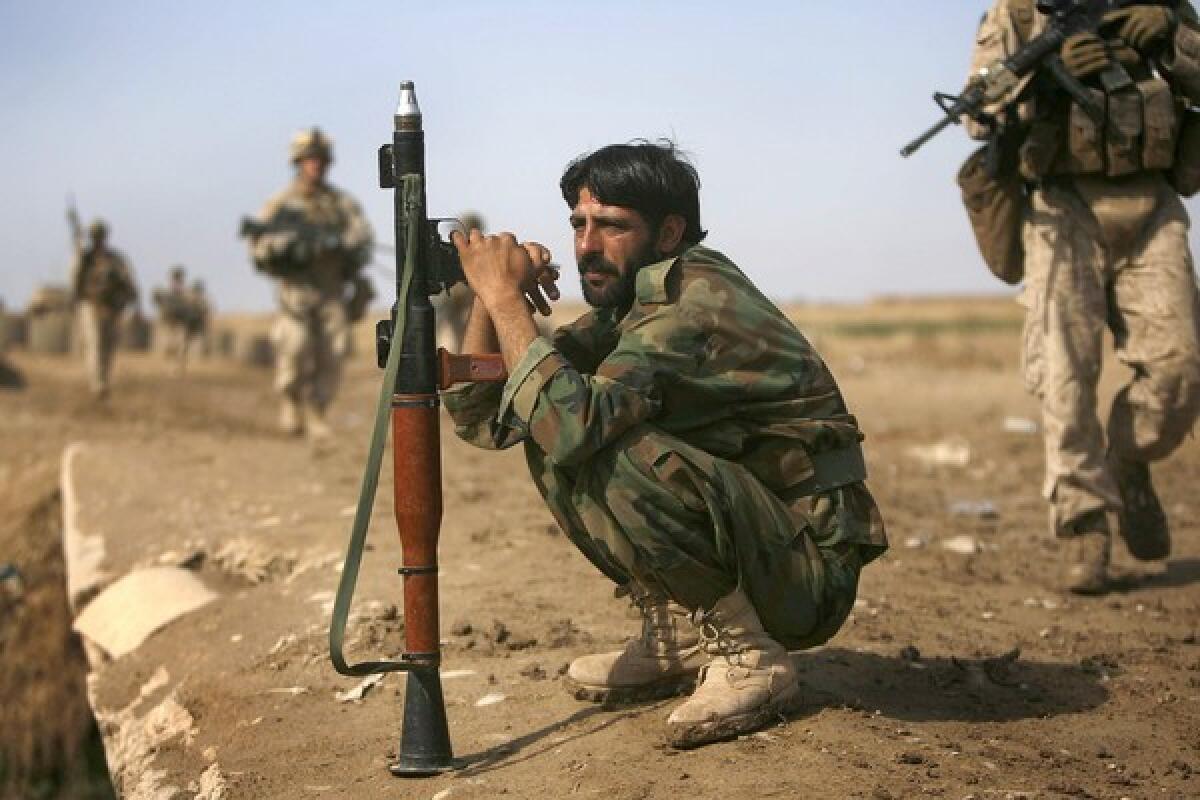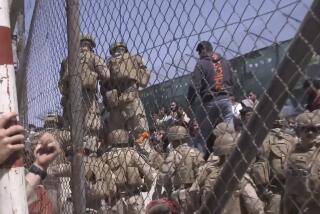Afghan soldiers show improvement in Marja assault

- Share via
Reporting from Marja, Afghanistan — The Afghan troops who supported the U.S. Marines in the battle to end Taliban control of this town in Helmand province showed marked improvement over last summer’s performance in a similar fight but still need much more training, Marine commanders say.
Brig. Gen. Larry Nicholson, the top Marine here, said that overall the Afghan battalions exceeded his expectations. Nicholson said he would give some Afghan units an A-minus or B-plus but that others, particularly those with soldiers fresh from basic training, would get a C-minus or D.
The lead Afghan commander, Brig. Gen. Mahayoodin Ghoori, agreed with Nicholson’s assessment. “We fought hard, we beat the terrorists, but we need more training, especially more training with heavy weapons,” Ghoori said.
The fight to oust the Taliban has been billed as a major test of the Afghan army’s state of readiness to assume the lead role in providing security for the nation.
Army Gen. Stanley A. McChrystal, the top U.S. commander in Afghanistan, has called for improving the Afghan army’s training and increasing its size and capability. That priority has taken on added urgency since President Obama declared in December that he wants to begin withdrawing U.S. combat troops by mid-2011.
The Marines are moving to boost Afghan training by emphasizing combat leadership among the enlisted ranks and more accurate use of M-16s. The project goes by the acronym TLSR: Transition of Leading Security Responsibility.
“There is plenty of room to improve marksmanship training,” said Col. Burke Whitman, the Marines’ liaison to the Afghan army and police. “Our biggest focus of training is shooting skill.”
On Thursday, the Afghan government held a formal flag-raising ceremony and installed a new civilian administration in Marja, a former Taliban stronghold. Marines, with British and Afghan troops, launched the 15,000-troop assault Feb. 13. Eight Marines, two Afghan soldiers and an Afghan police officer were killed in what was the largest single Western offensive since the U.S.-led invasion of Afghanistan in 2001. No official tally of Taliban dead has been kept; the number is thought to be in the hundreds.
During the height of the fighting, on the third day of the offensive, the Marines and Afghans were engaged in 36 sustained firefights with Taliban fighters. Though Afghan troops showed a willingness to fight, their effectiveness was questionable, Marines said.
“They were putting rounds down range, just like the Marines,” said Lt. Col. Calvert Worth, whose battalion saw some of the heaviest fighting. “Whether they were hitting anything is another question, but they were definitely in the fight.”
Although the battle plan called for the Marines to take the lead, the Afghans took the lead in capturing one key piece of terrain. “I asked the Marines later, ‘Why didn’t you fire?’ ” Nicholson said. “They said they didn’t need to, the Afghans were in charge.”
Other units, however, did not show the same level of aggressiveness or leadership. To boost the numbers of Afghans in the force, units whose soldiers had only eight weeks of basic training were included.
“The average Marine has a year’s worth of training before he goes into combat,” said Capt. Chuck Hayter, an operations officer assigned to work with the Afghans. “You can’t expect someone with eight weeks of training to match that.”
Frontline troops saw a full spectrum of competency among the Afghans. “Some were very good, some not good, and some so-so,” said Staff Sgt. Joseph Wolfgeher.
Last summer when Marines moved overnight to wrest several Helmand province farming communities from Taliban control, the Afghan army could muster only about 600 troops. Some fought bravely, but others refused to advance, much to the consternation of Nicholson, who did not hide his disappointment.
For that offensive, the ratio of Marines to Afghans was 10 to 1. For the Marja push, about 2,000 Afghan soldiers and police turned out, and the ratio of Marines to Afghans was 2.5 to 1.
“They did well for where they are in the development of their army,” said Col. Randy Newman, commander of the 7th Marine Regiment. “They were never shy about making contact. Sometimes we had to restrain them.”
Afghans were assigned one of the more dangerous missions: searching buildings for Taliban fighters and weapons caches. An Afghan police officer was killed in a booby-trapped building.
Whitman, who is preparing a detailed review of the Afghans’ performance, said he saw something on the eve of the assault that led him to be particularly encouraged. While Ghoori was delivering a pep talk to his soldiers, many of them pulled small Afghan flags out of their pockets and began waving them, Whitman said.
“The need for a paycheck may get men to enlist in the army,” Whitman said. “But to get them to fight, you need to believe in something, your country, and I think the Afghans are beginning to have it.”
More to Read
Sign up for Essential California
The most important California stories and recommendations in your inbox every morning.
You may occasionally receive promotional content from the Los Angeles Times.










